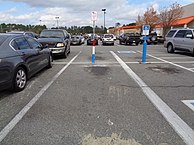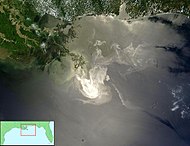False equivalence

A false equivalence or false equivalency is an informal fallacy in which an equivalence is drawn between two subjects based on flawed or false reasoning. This fallacy is categorized as a fallacy of inconsistency.[1] Colloquially, a false equivalence is often called "comparing apples and oranges."
Characteristics
[edit]This fallacy is committed when one shared trait between two subjects is assumed to show equivalence, especially in order of magnitude, when equivalence is not necessarily the logical result.[2] False equivalence is a common result when an anecdotal similarity is pointed out as equal, but the claim of equivalence does not bear scrutiny because the similarity is based on oversimplification or ignorance of additional factors. The pattern of the fallacy is often as such:
If A is the set containing c and d, and B is the set containing d and e, then since they both contain d, A and B are equal.
In an even more fallacious version, d is not required to exist in both sets; merely a similarity of two items d1 in set A and d2 in set B is cited to assert equivalence among the sets.[3]
Example:
If apples and oranges are both fruits, and there are seeds in both apples and oranges, then since they both contain seeds, apples and oranges are equal.[2]
Examples
[edit]The following statements are examples of false equivalence:[3]
- "The Deepwater Horizon oil spill is no more harmful than when your neighbor drips some oil on the ground when changing his car's oil."
- The "false equivalence" is the comparison between things differing by many orders of magnitude:[3] Deepwater Horizon spilled 210 million US gal (790 million L) of oil;[4] one's neighbor might spill perhaps 1 US pt (0.47 L).
- "They are both Felidae, mammals in the order Carnivora,[5] therefore there's little difference between having a pet cat and a pet jaguar."[6]
- The "false equivalence" is in an oversimplification[3] of the factors that make an animal a suitable pet.[7]
- "Consuming marijuana can lead to consuming and acquiring a psychological dependence on heroin later in life by acting as a gateway drug, so taking marijuana is like taking heroin."[8]
- The "false equivalence" is not considering the difference in likelihood. Consuming heroin is more likely to lead to future heroin dependence than taking marijuana, even given the assumption that one who begins using marijuana is more likely at some later time to try heroin, than someone who has never used marijuana.[8]
Negative consequence
[edit]False equivalence arguments are often used in journalism[9][10] and in politics, where flaws of one politician may be compared to flaws of a wholly different nature of another.[11]
Thomas Patterson of the Shorenstein Center on Media, Politics and Public Policy at Harvard University wrote about the false equivalency used by the media during the 2016 United States presidential election:
False equivalencies are developing on a grand scale as a result of relentlessly negative news. If everything and everyone is portrayed negatively, there's a leveling effect that opens the door to charlatans. The press historically has helped citizens recognize the difference between the earnest politician and the pretender. Today's news coverage blurs the distinction.[12]
See also
[edit]- Affirming the consequent
- Apophenia
- Equivocation
- False balance
- False analogy
- List of fallacies
- Tu quoque
- Whataboutism
- Wronger than wrong
References
[edit]- ^ Phillips, Harry; Bostian, Patricia (2014). The Purposeful Argument: A Practical Guide, Brief Edition (Second ed.). Cengage Learning. p. 129. ISBN 9781285982847.
- ^ a b Edward Webber, ed. (August 16, 2013). "False Equivalence". Truly Fallacious. Archived from the original on May 14, 2019. Retrieved February 17, 2017.
- ^ a b c d Bennett, Robert "Bo". "False Equivalence". Logically Fallacious. Retrieved November 27, 2018.
- ^ On Scene Coordinator Report on Deepwater Horizon Oil Spill (PDF) (Report). September 2011. Archived (PDF) from the original on September 15, 2012. Retrieved August 10, 2018.
- ^ Salles, L. O. (1992). "Felid phylogenetics: extant taxa and skull morphology (Felidae, Aeluroidea)" (PDF). American Museum Novitates (3047). Archived (PDF) from the original on April 18, 2017. Retrieved April 17, 2017.
- ^ "Cat or Lion: Differences Between Wild and Domestic Cats". Lone Tree Veterinary Medical Center. February 16, 2017.
- ^ "Distinguishing Cougars, Bobcats, and Domestic Cats". Department of Natural Resources. State of Michigan.
- ^ a b Finocchiaro, Maurice A. (1981). "Fallacies and the Evaluation of Reasoning". American Philosophical Quarterly. 18 (1): 13–22. ISSN 0003-0481. JSTOR 20013887.
- ^ Krugman, Paul (September 16, 2016). "The Falsity of False Equivalence". The New York Times. Retrieved February 17, 2017.
- ^ Phillips, Ari (August 26, 2016). "Welcome to the maddening world of false equivalence journalism (from a climate reporter who knows)". Fusion. Archived from the original on May 9, 2017. Retrieved February 17, 2017.
- ^ Buchanan, Neil H. (June 22, 2016). "The False Equivalence of Clinton and Trump's Negatives". Newsweek. Retrieved February 17, 2017.
- ^ Patterson, Thomas E. (December 7, 2016). "News Coverage of the 2016 General Election: How the Press Failed the Voters". Shorenstein Center.
Further reading
[edit]- Ferrell, Jason (February 15, 2021). "On moral equivalence". SN Social Sciences. 1 (2): 64. doi:10.1007/s43545-021-00070-4. S2CID 234324904.
External links
[edit]- Wunderlich, Annelise (June 13, 2019). "False Equivalence: Why It's So Dangerous". KQED.
- Sarkis, Stephanie (May 19, 2019). "This Is Not Equal To That: How False Equivalence Clouds Our Judgment". Forbes.


